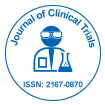
Journal of Clinical Trials
Open Access
ISSN: 2167-0870

ISSN: 2167-0870
Research Article - (2024)Volume 14, Issue 4
Background: Inflammation of gingival tissues in response to bacterial plaque accumulation is a key risk factor for the onset of gingivitis and progression towards periodontal inflammation. Thus, control of gingival inflammation is a prerequisite to sustain gingival health. Honey has been used in gingivitis and periodontal diseases for its antibacterial and healing properties, on the other hand, use of aloe-vera gel for its anti-inflammatory properties, has been reported in dentistry for many oral conditions. The main objective of the study was to find out the effects of gingival massage with aloe-vera gel and sidr honey as adjuvant to nonsurgical therapy in gingivitis and to find out whether there is a difference in the efficacy of aloe-vera gel and sidr honey in reducing plaque index, gingival index and bleeding on probing after one month of their application.
Method: 105 patients with gingivitis were selected in this single-blinded Randomized control clinical trial. At recruitment non-surgical therapy i.e. ultra-sonic scaling was performed. At baseline all clinical parameters, gingival index, plaque index and bleeding on probing were recorded. All the participants were then randomly divided into three groups, Group A: SRD and Gingival massage with Aloe-vera gel, Group B: SRD and Gingival massage with Sidr honey and Group C SRD only. On 30th day of trial all the patients were re-examined for all the clinical parameters.
Results: Gingival massage with both interventions showed statistically significant improvement in plaque index, gingival index and bleeding on probing when used as adjunct to non-surgical therapy. In Group A and B highly, significant differences were observed in plaque index (<0.001), gingival index (<0.001) and bleeding on probing after gingival massage with interventions when compared with control group. However, when gingival massage with aloe-vera gel vs. honey was compared significant differences were observed in gingival index. In contrary highly significant differences were observed in honey vs. control and aloe-vera vs. control groups.
Conclusion: This clinical trial showed that gingival massage with both naturopaths Aloe-vera gel and sidr honey had significant effect in reducing plaque index, gingival index and bleeding on probing when used as adjuncts in patients with gingivitis. However, sidr honey gingival massage was more effective than aloe-vera gel in comparison to control group.
Periodontitis; Aloe-vera gel; Honey; Gingival massage
SPSS: Statistical Package for the Social Sciences; BOP: Bleeding on Probing; PI: Plaque Index; GI: Gingival index; SRD: Scaling and Root Debridement
The oral cavity fosters a complex microbiota comprised of more than 700 different bacterial species which resides in dental plaque [1,2]. Dysbiosis of microbiota is the primary key factor that leads to gingival inflammation. Plaque-induced gingivitis is an inflammatory response of the gingival tissues resulting from bacterial plaque accumulation located at and below the gingival margin [3]. Epidemiologic data have shown, plaque-induced gingivitis to be prevalent at all ages in dentate populations [4], and this disease is considered the most common form of periodontal disease, creating a complex dynamic between the dental plaque biofilm and the host's immune inflammatory response [1,4,5]. Patients may notice symptoms that include bleeding with tooth brushing, blood in saliva, gingival swelling and redness, and halitosis in the case of established forms [5]. The common clinical signs of plaque-induced gingivitis include erythema, edema, bleeding, tenderness, and enlargement [3], however, gingivitis may not cause tooth loss but primary prevention against Periodontitis is to subside gingivitis [1,4]. Hence treatment and maintenance is necessary for gingivitis. The primary goal for treatment of gingivitis includes removing of microbial agents and risk factors to prevent progression of disease and establishing a maintained gingival tissue health [6]. Mechanical method for plaque control is tooth brushing [6], but in gingivitis, there is a need for professional dental care which includes non-surgical periodontal therapy [7]. This therapy is aimed to abolish bacterial plaque and calculus from supra gingival and sub gingival areas and to resolve the gingival health. After NSPT a number of topical antiseptics, anti-inflammatory and antibiotics agents are available which promotes healing of gingival tissues and are beneficial in treatment of gingivitis [8-10].
Gingival massage is also a method to treat gingival tissues. Gingival massage works by stimulating the blood circulation, provoking active hyperemia, and thus increasing tissue respiration and transport of detritus products [11]. Another effect of massaging gingiva is to churn out dense connective tissue, which in turn increases keratinization of gingival tissues. In surmising, the advantages of massage are: A healthier gingival circulation, periodontal stimulation, abolition of food debris, dwindling bacteria and mucinous plaques, and the keratinization of epithelium encircling the tooth which firms and narrows the orifice to the pocket [12,13]. A study compared gingival massage of three different oils (sesame, coconut, and olive oil) and chlorhexidine gel in reducing oral microorganisms, they concluded significant reduction of microorganisms, plaque scores and gingival scores, and however no significant difference was found among the four groups [14].
In recent years a lot of herbal medicine has been used in dentistry such as green tea, olive oil, turmeric, almond oil. Honey and aloe vera have been used in gingivitis, periodontitis, root canal medicament and post extraction healing sockets for their beneficial effects [15-18]. Honey has antibacterial activity and was first recognized by Ketel et al. in 1892 [19]. Natural honey is a simple, effectual, cheap and cheerful agent, which is obtainable, and it can be an affordable therapeutic agent [20]. Honey has healing properties, subsides pain, infection, inflammation and also removes malodor [21]. It is easily available with no side effects or toxicity nor any resistance reported, with all these favorable reasons honey can be used as an alternative to antimicrobial therapy [22,23].
A study compared honey, mouthwash and combination of chewing gum and mouthwash on plaque level and concluded honey group and mouthwash with chewing gum group were more effective than mouthwash group alone [24]. Molan suggested, the use of soft gelled form of honey can be applied on the gingival margin periodically to prevent gingivitis or colonization of caries causing bacteria on the gingiva [20]. Researcher’s claims that honey candies may prevent halitosis or oral bad breath, as honey is found to rapidly remove bad smell from infected wounds. Literature indicated that honey can be used in the treatment of dry socket, mouth ulcers and periodontitis. The anti-inflammatory action of honey gives the soothing effect on topical applications [25]. The antioxidants present in honey along with the anti-inflammatory action prevent the deterioration of gingival and periodontal tissues [18-20,22,23,26,27].
Aloe-vera (Alloeh) means "shiny bitter substance" and "vera" a Latin word means "genuine" [17,28]. comprise of vitamins, enzymes, minerals, amino acids and sugars. Aloe-vera gel medicinal effect in animal models, in vitro or in oral cavity has shown to have anti- inflammatory, anti-arthritic, and anti-bacterial effects [15,17,28,29]. Aloe-vera gel has shown favorable results when applied directly to the traumatized gum tissues which are caused by toothpick or dentifrice abrasives. It also helps to sooth chemical burns from aspirin and aids in healing of extraction sockets [15,17,28,30]. Due to all these beneficial effects of honey and aloe-vera gel, use of these natural products can be considered an admissible method for controlling and preventing gingival inflammation. Topical allopathic gel application may cause some side effects like altered taste sensation, dryness, itching and swelling of oral mucosa, on contrary natural pharmacons like honey and aloe-vera gel, may not cause severe side effects, but also acts as antibacterial and anti- inflammatory agent.
Taking this into account, this clinical trial was conducted to compare the effects of gingival massage efficacies of honey and aloe-vera gel as adjunct to non-surgical therapy in patients with gingivitis, for this purpose, we assessed clinical parameters which were plaque index, gingival index and bleeding on probing.
Study design and study setting
The randomized controlled clinical trial was conducted in department of Periodontology at Dow university of Health Sciences, Karachi, Pakistan. This clinical trial was approved by the Institutional Review Board of Dow University of Health Sciences (Ref: IRB-1272/DUHS/Approval/2019/55). The research protocol was registered with the Protocol Registration and Results System at ClinicalTrials.gov, under the protocol ID NCT05231096, on February 9, 2022 in accordance with the CONSORT statement of the updated guidelines.
Characteristics of participants
Written consent was obtained from all participants to participate in the four-week clinical trial. Study included participants without systemic disease, both male and female, 20-60 years of age with plaque induced gingivitis, presence of plaque, signs of gingival inflammation and bleeding on probing ≥ 20% sites, pocket depths of 1-3 mm and no clinical attachment loss. Minimum of 5 teeth in each quadrant excluding 3rd molars. Individuals who smoke, any addiction of areca nuts, gutka, paan or alcohol, any systemic diseases like diabetes mellitus, cardiovascular, endocrine as they may affect the outcome of research, women with pregnancy/ lactation, and individuals with any known allergy from aloe-vera or honey, systemic or topical use of antibiotic in past 6 months were excluded from the study. In this clinical trial, 105 patients diagnosed with plaque induced gingivitis were recruited. The enrollment, allocation of patients and intervention given to the teeth is given in Figure 1.
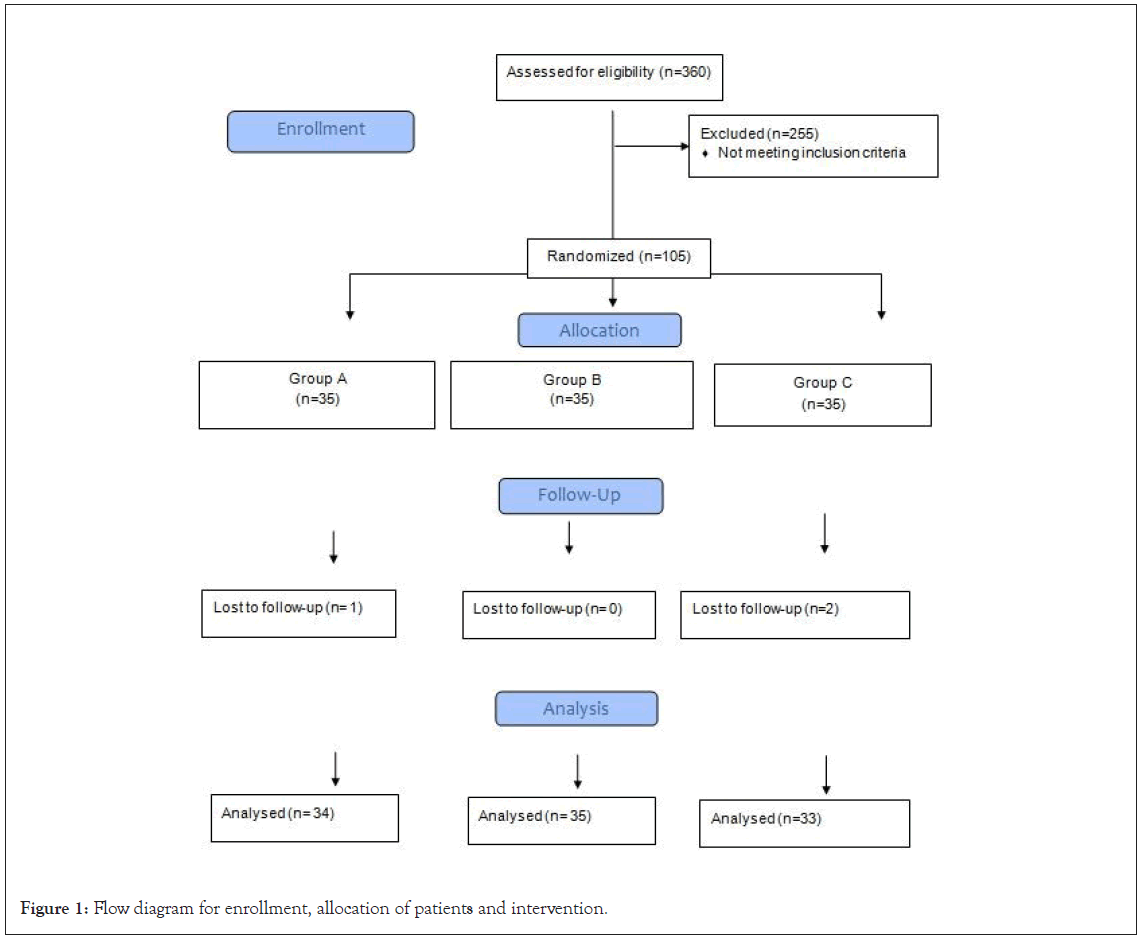
Figure 1: Flow diagram for enrollment, allocation of patients and intervention.
Sample size calculation
Total of 105 patients were calculated (35 in each group) by using PASS version 11 software, paired sample t-test with 95% confidence interval and 80% power of test. Difference of plaque index at base line versus after 1 month mean 20.02 ± 68.16, calculated sample size was 93, which was increased to 105 [29].
Description of interventions
Aloe-vera gel production: Aloe vera gel used in this study was, 98% aloe vera gel concentration mixed with 2% normal saline. Preparation of aloe-vera gel was from ripen leaves of aloe-vera [29]. Aloe vera leaves were washed thoroughly under water, then cut from the center, and the seeping gel was collected in sterile container, was stored at 4°C, until the time of application. In our research this pure Aloe vera gel (Figure 2), was extracted by The Pakistan Council of Scientific and Industrial Research (PCSIR) laboratory.
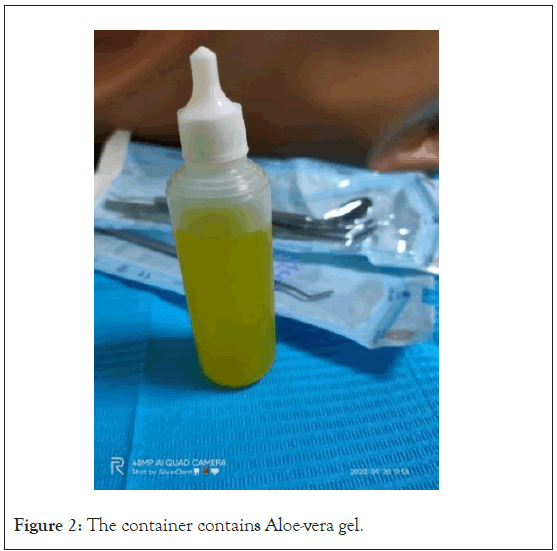
Figure 2: The container contains Aloe-vera gel.
Honey collection: Sidr (Beri) honey (Figure 3), was used in this study. Honey was thick, raw and cold. It extracted from Sidr trees. It was smooth, viscous and medium to dark amber in color.
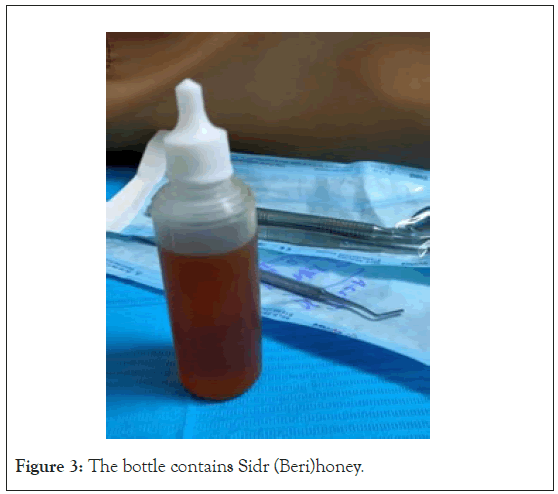
Figure 3: The bottle contains Sidr (Beri)honey.
Data collection procedure
Participants, signing the consent form were enrolled in the study. All the enrolled participants went through a detailed history which included medical health, systemic illness, regular medications, hospitalizations, any known allergies, dental checkups, any bad oral habit and routine oral hygiene practice. Any entrant having any allergy from honey or aloe-vera gel or anyone falling in our exclusion criteria were not selected in our research. All those who fulfilled our criteria were clinically examined and all the clinical parameters were recorded by the principal investigator at the baseline, i.e. gingival index, plaque index and bleeding on probing. Bleeding on probing (Figure 4), was checked on the buccal and lingual sulcus of tooth, after inserting the probe and wait of 30 seconds, if bleeding occurred, bleeding on probing was considered as 1 and labeled as positive Bleeding on Probing (BOP), and if there was no bleeding, it was considered as 0 and labeled as no bleeding on probing. Percentage of BOP was recorded by dividing positive bleeding sites by total number of sites present in each patient multiplied by 100. Gingival index (Loe and Silness, 1963) was recorded as score 0: Normal gingiva, 1: Mild inflammation on gingiva, 2: Moderate inflammation on gingiva and 3: Severe inflammation on gingiva. Plaque index (Loe and Silness, 1964) was recorded as score 0: No plaque, 1: plaque film on free gingival margin, 2: Moderate plaque on gingival margin; can be seen by the naked eye, 3: Abundance of soft matter in gingival pocket. After recording all the clinical parameters, principal investigator performed non- surgical periodontal therapy (scaling and root debridement) by using ultrasonic scalers in single visit. Following scaling and root debridement (Figure 5), the participants of all the three groups were given detailed oral hygiene instructions with demonstration of proper brushing technique i.e. Modified Bass technique. After that, all the participants were provided with a regular cleaning kit which consisted of fluoride toothpaste (Colgate® Cavity Protection Toothpaste) and toothbrush (Colgatew Classic Clean Toothbrush). Moreover, all enrolled patients in Group A and B were minutely demonstrated by principal investigator for gingival massage. Intra- examiner reliability was checked to ensure calibration between examiners. For this purpose, both examiners recorded clinical parameters of 50 subjects with gingivitis who were not involved in our study and reliability came out to be 88%.
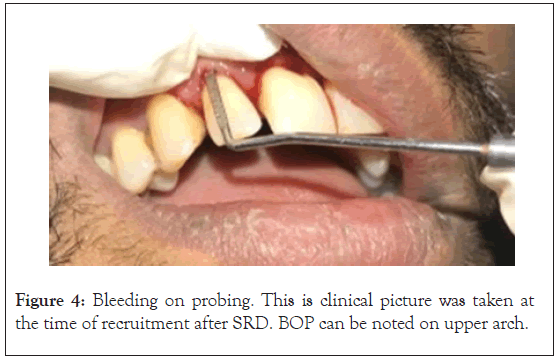
Figure 4: Bleeding on probing. This is clinical picture was taken at the time of recruitment after SRD. BOP can be noted on upper arch.
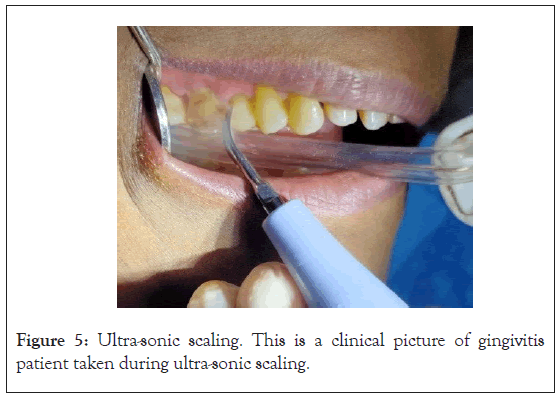
Figure 5: Ultra-sonic scaling. This is a clinical picture of gingivitis patient taken during ultra-sonic scaling.
Random allocation of intervention
A total of 105 participants were divided in to three groups and were named as Group A: Gingival massage with Aloe-vera gel, (Figure 6), Group B: Gingival massage with Sidr honey (Figures 7a and 7b), and group C: Control group. Interventions were randomly allocated. For this purpose, entrants were asked to pick one sealed opaque envelope in which random allocation of the interventions were mentioned. All the participants who were in Group A and B were not blinded and trained for gingival massage by principal investigator. All the participants were guided to rub aloe-vera gel or sidr honey on the skin of wrist first to recheck any allergy. At last participants were trained for application of the material gently on the gingiva and the gingival sulcus of all the teeth. To perform gingival massage patients used the index finger of their dominant hand, applied the material at the bottom of their gums with slight pressure, then moved the finger in a slow and circular motion/ rubbing action for 1 to 3 minutes. After performing the massage patients were not allowed to rinse with water or any other fluids for 30 minutes for further retaining the material on the gingiva and in the gingival sulcus thereby preventing washing out of the material. All the patients were instructed to perform gingival massage with aloe-vera gel and sidr honey twice a day after meals and to wait for 30 minutes after application of the interventions. All the routine oral hygiene practice which includes brushing twice a day (morning and night) was continued as usual. Patients falling in the control group were instructed to follow routine oral hygiene protocols. Telephonic communications were made weekly for encouraging the patients for gingival massage with given interventions. All the patients were recalled on 30th day for Post-intervention assessment (Figures 8a and 8b). The baseline clinical parameters were recorded by principal investigator whereas 1-month follow-up of all clinical parameters were recorded by a trained examiner in this study. The trained examiner who was blinded from the intervention given to patients, was asked to re-assess all the clinical parameters which included gingival index, plaque index and bleeding on probing. Study Variables were included Gingival Index [GI], Plaque Index (PI), Bleeding on Probing (BOP).
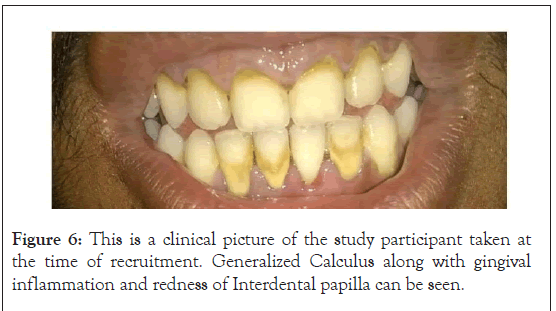
Figure 6: This is a clinical picture of the study participant taken at the time of recruitment. Generalized Calculus along with gingival inflammation and redness of Interdental papilla can be seen.
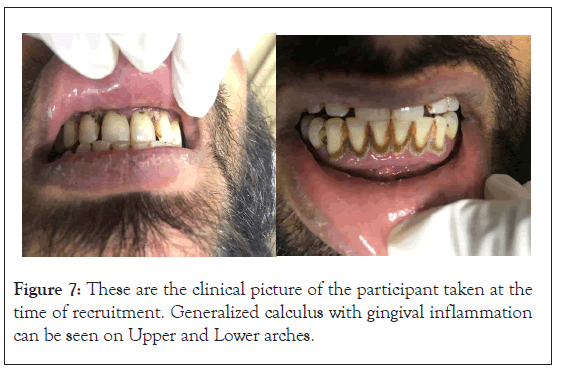
Figure 7: These are the clinical picture of the participant taken at the time of recruitment. Generalized calculus with gingival inflammation can be seen on Upper and Lower arches.
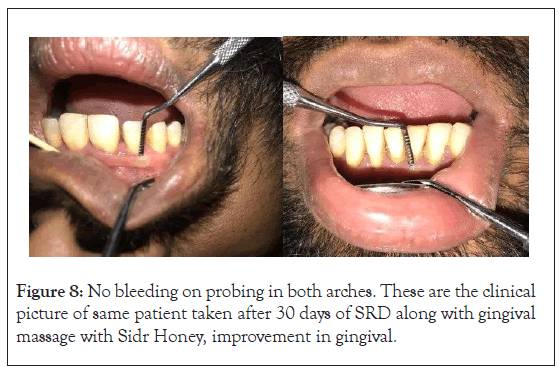
Figure 8: No bleeding on probing in both arches. These are the clinical picture of same patient taken after 30 days of SRD along with gingival massage with Sidr Honey, improvement in gingival.
Statistical analysis
Data processing and analysis was done by using IBM SPSS version 21.0 software. As per appropriate distribution, Data for each tooth site was entered in Microsoft excel for pocket depth and mean score was calculated for baseline and same sites were observed for improvement after 1 month. Percentages were reported for plaque index and gingival index. Percentages were reported for bleeding on probing, cutoff of ≥ 20% and ≥ 30% was set to analyze before and after differences in bleeding on probing in all three groups. Non-parametric test like Wilcoxon signed ranked test and Mann Whitney test were applied. Wilcoxon signed ranked test was applied for pre- and post-comparison within groups for gingival index, and plaque index. Mann Whitney test was applied to analyze statistically significant differences between groups in gingival index, and plaque index. The p-value of<0.05 was considered as significant.
Ethical consideration
The present study was safe for all the patients as the study was completely non-invasive. All the participants signed a written consent form prior to inclusion. There was only topical application of natural products i-e Aloe-vera gel and Sidr Honey which have already been used in other studies and no known adverse effects and complications have been reported.
A total of 105 patients were recruited in three groups’ i.e., Group A (gingival massage with Aloe-vera gel), Group B (gingival massage with Sidr Honey) and Group C (control group), and out of these three participants were loss to follow-up, one from group A and two from group C. There were 57 (56%) males and 45 (44%) females with an average age of 48 ± 8.6 years.
Comparing gingival massage effects on plaque index
In all the three groups significant reduction in plaque levels within groups were observed (Table 1). Moreover, Aloe-vera vs. honey (p-value>0.05) showed no significant changes, whereas honey vs. control (p-value<0.001) and Aloe-vera vs. control (p-value<0.001) showed statistically significant differences. (Table 2).
| Group plaque index | Before application N=102 |
After application N=102 |
|---|---|---|
| Aloe-vera gel | N=34(%) | N=34(%) |
| No | 0(0) | 12(35) |
| Light | 6(18) | 18(53) |
| Moderate | 16(47) | 4(12) |
| Severe | 12(35) | 0(0) |
| Sidr honey | N=35 (%) | N=35 (%) |
| No | 0(0) | 16(46) |
| Light | 8(23) | 15(43) |
| Moderate | 17(49) | 4(11) |
| Severe | 10(29) | 0(0) |
| Control | N=33 (%) | N=33 (%) |
| No | 0(0) | 5(15) |
| Light | 4(12) | 13(39) |
| Moderate | 15(46) | 14(42) |
| Severe | 14(42) | 1(3) |
Table 1: Gingival massage effects on plaque index among groups.
| Between group | P-valueɞ | P-valueɞ | |
|---|---|---|---|
| Aloe-vera vs. honey | 0.49 | >0.05 | -- |
| Honey vs. control | 0.15 | <0.001 | -- |
| Aloe-vera vs. control | 0.46 | <0.001 | -- |
Note: ɞMann-Whitney Test; ᵱ Wilcoxon signed ranked test
Table 2: Gingival massage effects on plaque index.
Comparing gingival massage effects on gingival index
In group A, B and C statistically significant changes were seen with P-value<0.001 within groups. Highly significant differences were observed between group A and C (Tables 3 and 4).
| Group gingival index |
Before application N=102 |
After application N=102 |
|---|---|---|
| Aloe-vera gel | N=34(%) | N=34(%) |
| Normal | 0(0) | 12(35) |
| Mild | 14(41) | 22(65) |
| Moderate | 20(59) | 0(0) |
| Severe | 0(0) | 0(0) |
| Sidr honey | N=35(%) | N=35(%) |
| Normal | 0(0) | 23(66) |
| Mild | 16(46) | 12(34) |
| Moderate | 19(54) | 0(0) |
| Severe | 0(0) | 0(0) |
| Control | N=33(%) | N=33(%) |
| Normal | 0(0) | 7(21) |
| Mild | 10(30) | 20(61) |
| Moderate | 23(70) | 6(18) |
| Severe | 0(0) | 0(0) |
Table 3: Gingival massage effects on gingival index among group.
| Between group | P-valueɞ | P-valueɞ | |
|---|---|---|---|
| Aloe-vera vs. honey | 0.76 | <0.05 | -- |
| Honey vs. control | 0.19 | <0.001 | -- |
| Aloe-vera vs. control | 0.35 | <0.05 | -- |
Note: ɞMann-Whitney Test; ᵱ Wilcoxon signed ranked test
Table 4: Gingival massage effects on gingival index.
Comparing gingival massage effects on bleeding on probing
After gingival massage with Aloe vera gel only 14.7% bleeding on probing sites were left whereas in honey group only 8.6% sites were present. In control group 36.4% sites were left when cutoff was set at ≥ 30% (Table 5).
| Bleeding on probing | Aloe-vera gel (n=34) |
Sidr honey (n=35) |
Control (n=33) |
|
|---|---|---|---|---|
| ≥ 20% sites | Before GM | 34(100%) | 35(100%) | 33(100%) |
| After GM | 5(14.7%) | 3(8.6%) | 33(100%) | |
| ≥ 30% sites | Before GM | 34(100%) | 35(100%) | 33(100%) |
| After GM | 1(2.9%) | 0(0%) | 12(36.4%) | |
Note: GM: Gingival Massage
Table 5: Gingival massage effects on bleeding on probing.
Plaque-induced gingivitis is one of the most frequent periodontal diseases, affecting more than 90% of the population, regardless of age, sex or race [31-34]. Gingival tissues can heal after complete removal of factors i.e. plaque and calculus, and optimizing oral hygiene protocols. Till date scaling and root debridement is the most basic procedure to optimize the gingival and periodontal tissues [8,35]. However, the therapy alone does not restore all the gingival tissues and supplementary aids are used as adjuvant to scaling and root debridement [29,35]. A bundle of studies has claimed favorable effects of natural products like olive oil, almond oil, green tea, propolis, honey and aloe vera [25,29,30,36-38].
In this study we observed synergistic effects of gingival massage with two naturopaths that is aloe vera gel and sidr honey compared with control group. Our study comprises of 102 participants of gingivitis, mean age reported in our study is 48.6 ± 8.6 which is similar to a survey in United States which reported higher prevalence of gingivitis in adults with mean age as>30 years [39]. Likewise, another study which was done in Saudia reported age group to be 18 to 40 years [40], which is concordant to the current study. In this study, gingivitis was found more in males as compared to females. While some previous studies showed that more females were diagnosed with gingivitis as compared to males [4].
In present study, gingival massage effect was favorable with both interventions. However significant differences were noted in between aloe-vera gel and sidr honey. In Aloe vera gel gingival massage group, there was significant reduction of plaque index, gingival index and bleeding on probing when compared with control group. There are some studies which reported similar findings regarding use of aloe vera gel [27]. However the synergetic effects of gingival massage with aloe vera gel, has not been documented. However, a study conducted in Brazil reported no significant differences in plaque index and gingival index, between aloe vera and control group, conflicting the findings of this research [29]. An in vitro study demonstrated high antimicrobial effects of aloe vera tooth gel against streptococcus mitis, when compared with commercially available toothpaste [41]. It is noteworthy that aloe vera gel comprises a unique blend of ingredients, which are responsible for antibacterial, antiseptic, anti-oxidant and anti- inflammatory properties [30,42-44]. Furthermore it causes wound healing by proliferation of fibroblast, by initiating angiogenesis or activating macrophages, all these above mentioned properties may play key role behind diminution of gingival index, plaque index and bleeding on probing [45,46].
Regarding Sidr honey gingival massage group, highly significant differences in gingival index, plaque index and bleeding on probing were observed when compared with control group. This finding is somewhat similar to many studies conducted by using variety of honey as a topical gel, chewing gum or mouthwash [22,24,47]. However, there is a dearth of literature regarding effects of Sidr honey on gingivitis.
A study conducted in New Zealand in year 2017 reported, topical application of Manuka honey is effective in antimicrobial plaque control, and more sensitive against gram negative anaerobes, primarily causing gingivitis [18]. Likewise, research reported significant reduction in plaque levels and gingivitis when a chewable Manuka honey product was used three times a day for ten minutes. This study favors results of present study [48]. Moreover, a study done in Malaysia, reported conflicting results from present research [49]. It is worth mentioning that variations in floral honey, determines different qualities and properties, moreover potential difference in reducing inflammation and microbial load is significant among darker and unheated honey [18,50,51]. In this present study Sidr honey has both of these qualities which may be a factor which halt bleeding on probing, diminishing gingival index and maintaining low plaque level [26,51-53].
This present study aims to compare gingival massage effects of Aloe- vera gel and Sidr honey on gingivitis by assessing the differences in plaque index, gingival index and bleeding on probing. In this research outcome of both the naturopaths results in diminishing all the clinical parameters, however there were significant statistical differences between Aloe-vera gel and sidr honey. Our study reported Sidr honey is highly significant in reducing all clinical parameters than Aloe-vera gel. A randomized controlled trial conducted in year 2015 concluded effective reduction in gingival scores, when gingival massage with honey or olive oil was done for 3 weeks. Another study conducted on patients having dry socket after extraction and having mouth ulcers also reported clinical improvement after topic honey application [16,36,51].
Moreover, studies conducted by Anushri and Aetraf inferred that honey can stimulate the growth of granulated tissues and the epithelial cells, which helps in periodontal tissue repair, thus eliminates periodontal pockets. These findings support the outcome of present study [22,43]. Likewise a latest clinical study conducted in Norway in year 2015 showed notable improvement in plaque index, probing pocket depth, and gain in clinical attachment loss after the placement of aloe vera gel in the periodontal pockets in type 2 diabetes mellitus [54]. Furthermore recent studies by Kurian and sundarker have reported increased granulation tissue in healing wound after topical application of aloe vera gel which is due to production of hyaluronic acid and dermatan sulfate [15,37,55]. Literature claims favorable effects of both the naturopath but it is worthy to note that periodontal therapy itself ceases the progression of gingivitis and halts its complications [23,56-60]. That being said, if good oral hygiene is practiced and reinforced then reduced plaque accumulation significantly helps to eliminate disease progression [7,61-63]. Eventually above reported literature supports the outcome of present study which is significant differences in clinical status of gingivitis patients when gingival massage of Aloe-vera gel and Sidr honey is used as adjuvant to scaling and root debridement, thus all of them may have synergistic effects in reducing all the clinical parameters.
Recommendations
In the future, more studies are needed to evaluate the diverse effects of gingival massage and its synergistic effects when combined with any naturopath like aloe-vera gel or sidr honey, as there are few studies and inconsistent results. Different methodologies and techniques maybe used to determine various results. More rigorous studies must be conducted because of the paucity of literature on gingival massage.
This clinical trial showed that gingival massage with both naturopath’s aloe vera gel and sidr honey were equally significant in reducing gingivitis, by diminishing plaque index, gingival index and bleeding on probing. However, findings suggest that sidr honey gingival massage was highly effective when compared to aloe vera gel and control group. This study provides an opportunity to perform oral hygiene procedures with natural products easily at home. Therefore, gingival massage with both the naturopaths is well-to-do as an adjunct to scaling and root debridement and it can be used in dental OPD’s for the treatment of gingivitis.
I would like to acknowledge department of periodontology for facilitation in data collection.
• FK was the principal investigator and has contributed to design, conception, data acquisition, interpretation, and drafted the manuscript.
• SAJ has contributed to conception, design, interpretation of results and critically revised the manuscript.
• WAF has contributed to data analysis, interpretation and contributed to statistical analyses.
• HP has contributed to data acquisition and Turnitin.
• SR has contributed to draft discussion and critically revised the manuscript.
• SS has contributed to draft background and data acquisition.
• MG has contributed to draft background and data acquisition
• ZRK has contributed to grammar checking and critically revised the manuscript.
All authors have conjointly given final approval and agreed to be accountable for all aspects of the work.
This clinical trial is not funded by any agencies in the public, commercial or not-for-profit sectors.
The datasets used and/or analyzed during the current study are available from the corresponding author on request.
Ethics approval and consent to participate: This clinical trial was approved by the Institutional Review Board of Dow University of Health Sciences (Ref: IRB-1272/DUHS/Approval/2019/55) and was registered under the protocol ID NCT05231096, on February 9, 2022 in accordance with the CONSORT statement of the updated guidelines for reporting randomized clinical trials. Written consent was obtained from all participants to participate in the four-week clinical trial.
Not applicable.
The authors declare that there is potentially no conflict of interest related to the article.
[Crossref] [Google Scholar] [PubMed]
[Crossref] [Google Scholar] [PubMed]
[Crossref] [Google Scholar] [PubMed]
[Crossref] [Google Scholar] [PubMed]
[Crossref] [Google Scholar] [PubMed]
[Crossref] [Google Scholar] [PubMed]
[Crossref] [Google Scholar] [PubMed]
[Crossref] [Google Scholar] [PubMed]
[Crossref] [Google Scholar] [PubMed]
[Crossref] [Google Scholar] [PubMed]
[Crossref] [Google Scholar] [PubMed]
[Crossref] [Google Scholar] [PubMed]
[Crossref] [Google Scholar] [PubMed]
[Crossref] [Google Scholar] [PubMed]
[Crossref] [Google Scholar] [PubMed]
[Crossref] [Google Scholar] [PubMed]
[Crossref] [Google Scholar] [PubMed]
[Google Scholar] [PubMed]
[Google Scholar] [PubMed]
[Google Scholar] [PubMed]
[Crossref] [Google Scholar] [PubMed]
[Crossref] [Google Scholar] [PubMed]
[Crossref] [Google Scholar] [PubMed]
[Google Scholar] [PubMed]
[Google Scholar] [PubMed]
[Crossref] [Google Scholar] [PubMed]
[Crossref] [Google Scholar] [PubMed]
[Crossref] [Google Scholar] [PubMed]
[Crossref] [Google Scholar] [PubMed]
[Google Scholar] [PubMed]
[Google Scholar] [PubMed]
[Crossref] [Google Scholar] [PubMed]
[Crossref] [Google Scholar] [PubMed]
[Google Scholar] [PubMed]
[Crossref] [Google Scholar] [PubMed]
[Crossref] [Google Scholar] [PubMed]
[Crossref] [Google Scholar] [PubMed]
[Crossref] [Google Scholar] [PubMed]
[Crossref] [Google Scholar] [PubMed]
[Crossref] [Google Scholar] [PubMed]
[Crossref] [Google Scholar] [PubMed]
[Crossref] [Google Scholar] [PubMed]
[Crossref] [Google Scholar] [PubMed]
[Crossref] [Google Scholar] [PubMed]
[Crossref] [Google Scholar] [PubMed]
[Crossref] [Google Scholar] [PubMed]
Citation: Khalid F, Ahmed S, Farooqui WA, Pervaiz H, Riaz S, Shabbir S, et al (2024) Comparative Efficacy of Gingival Massage of Aloe-Vera Gel and Sidr Honey on Gingival Health: A Randomized Clinical Trial. J Clin Trials. 14:562.
Received: 28-Mar-2024, Manuscript No. JCTR-24-30532; Editor assigned: 01-Apr-2024, Pre QC No. JCTR-24-30532(PQ); Reviewed: 15-Apr-2024, QC No. JCTR-24-30532; Revised: 22-Apr-2024, Manuscript No. JCTR-24-30532(R); Published: 29-Apr-2024 , DOI: 10.35248/2167-0870.24.14.562
Copyright: © 2024 Khalid F, et al. This is an open-access article distributed under the terms of the Creative Commons Attribution License, which permits unrestricted use, distribution, and reproduction in any medium, provided the original author and source are credited.